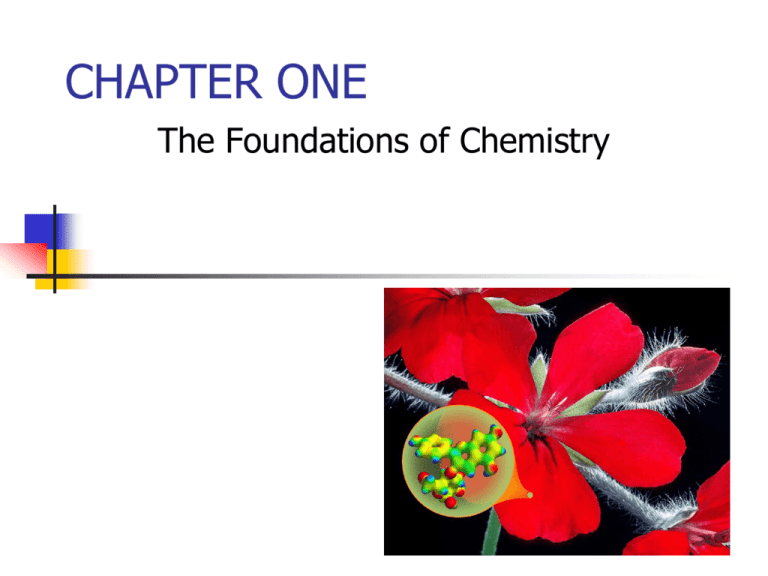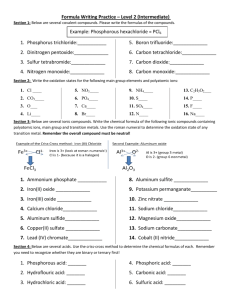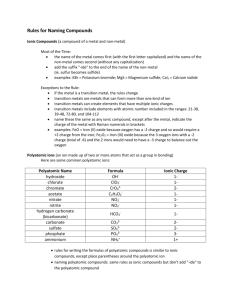Ch 1
advertisement

CHAPTER ONE The Foundations of Chemistry RECALL!!! Elements: Can not be broken down by chemical reactions Pure Substances Compounds: Can be broken down ONLY by chemical reactions Matter Homogeneous: Constant composition throughout Mixtures Can be separated by physical processes Heterogeneous: Variable composition throughout 2 States of Matter 3 E D B C A 4 States of Matter 5 Chemical and Physical Properties Chemical Properties - chemical changes rusting or oxidation chemical reactions Physical Properties - physical changes changes of state density, color, solubility 6 Question 1. Classify as mixtures (homogeneous or heterogeneous), compounds (ionic or molecular), or elements (monoatomic or molecular). Classification C2H5OH Cl2 Cu bronze 5% AgNO3 solution C6H12O6 PbCl2 precipitate Zn Ba3(PO4)2 0.5 M CaCl2 7 Mixtures, Substances, Compounds, and Elements 8 Separation of Mixtures Distillation: It separates 2 or more liquids with different boiling points. For example: ethanol (bp: 78°C) and water (bp: 100°C) Fractional crystallization: It separates 2 or more solids (by means of precipitation) with different solubility. Filtration: It separates an insoluble solid from a liquid. The solid must be insoluble in the liquid. For example: sandwater, silver chloride-water. Chromatography: It separates substances that are soluble in a solvent by means of IMF. Evaporation: It separates a soluble solute from its solvent by evaporating the solvent. For example: NaCl-H2O Liquid – liquid separation: It separates 2 immiscible liquids using a separatory funnel. For example: oil-water Distillation Ethanol-water Separates homogeneous mixture on the basis of differences in boiling point. 10 Filtration Separates insoluble solid substances from liquids and solutions. 11 Chromatography: Separates substances on the basis of differences in solubility in a solvent and IMF. 12 Measurements in Chemistry Quantity length mass time current temperature amt. substance Unit meter kilogram second ampere Kelvin mole Symbol m kg s A K mol 13 Measurements in Chemistry Metric Prefixes Name mega kilo deci centi milli micro nano pico femto Symbol M k d c m μ n p f Multiplier 106 103 10-1 10-2 10-3 10-6 10-9 10-12 10-15 14 Units of Measurement Common Conversion Factors Length Volume 2.54 cm = 1 inch 1 liter = 1.06 qt Mass 1 lb = 454 g 15 Volume The most commonly used metric units for volume are the liter (L) and the milliliter (mL). 1 dm = 10 cm 3 3 1 dm = 1000 cm 1 L = 1000 mL therefore 3 1 mL = 1 cm 16 Uncertainty in Measurements Different measuring devices have different uses and different degrees of accuracy. 17 Relationships of the Temperature Scales Kelvin and Celsius Relationship K = °C + 273.15 Fahrenheit and Celsius Relationship °F = 1.8 * °C + 32 18 Use of Numbers Exact numbers Accuracy 1 dozen = 12 things for example how closely measured values agree with the correct value. The experimental value is 23.5148g, the actual value is 23.5150g. These 2 masses are accurate. Precision how closely individual measurements agree with each other. The value of the mass of the same beaker in 3 trials are: 23.5148g, 23.5152g, 23.5145g. These values are precise. 19 Percent error Percent error = accepted – experimental x 100 accepted From previous example: % error = 23.5150 – 23.5148 x 100 = 0.0009 % 23.5150 20 Use of Numbers Significant Figures – Rules All non-zero digits are significant. Leading zeroes are never significant Imbedded zeroes are always significant. 2.0059 has five sig fig Trailing zeroes are only significant after the decimal point. 0.000357 has three significant figures 1300 g has 2 sig fig 13.00 g has 4 sig fig Use scientific notation to remove doubt 1.300 x 103 has 4 significant figures 21 Use of Numbers Multiplication & Division rule Easier of the two rules Product has the smallest number of significant figures of multipliers 4.242 x 1.23 2.7832 x 1.4 5.21766 round off to 5.22 3.89648 round off to 3.9 22 Use of Numbers Addition & Subtraction rule More subtle than the multiplication rule Answer contains smallest decimal place of the addends. 3.6923 2.02 8.7937 2.123 6.9463 round off to 6.95 6.6707 round off to 6.671 1.234 23 Use of Numbers On a multi-step question, solve all mathematical steps and ONLY round off the final answer. 24 Using Factor Label Method Example: A concentrated hydrochloric acid solution is 36.31% HCl by mass. The density of the solution is 1.185g/mL. What mass of pure HCl is contained in 175 mL of this solution? Some Possible Unit Factors from this Problem 36.31 g HCl 36.31 g HCl 63.69 g H 2 O or or 63.69 g H 2 O 100.00 g solution 100.00 g solution g density 1.185 mL 1.185 g soln 36.31 g HCl 175 mL soln 1 mL soln 100.00 g soln 75.3 g HCl 25 Problem 2. Calculate the volume of solution required to prepare 0.025 M solution of Na2SO4 if only 0.050g of the salt is available. Known: Molar mass of Na2SO4 is 142.1 g/mol. 0.025 M means 0.025 mol/L. 26 Problem 3. Calculate the density of a cobalt(II) chloride solution with a molarity of 3.57 M and a percent mass by mass of 17.46%. 27 Review Nomenclature Compounds: Ionic Covalent Hydrates Acids Ionic compounds Binary Two elements Metal Groups IA, IIA, Al, Ag, Zn, Cd Only one oxidation number Name of the metal does not change: lithium, calcium + Ternary More than two elements Nonmetal Other metals More than one oxidation number Roman numerals to specify charge: iron(II), iron(III), tin(II), tin(IV) Stem of element + ide oxide, sulfide, chloride Ionic compounds Binary Two elements Ternary More than two elements Metal or NH4+ Groups IA, IIA, Al, Ag, Zn, Cd Only one oxidation number Name of the metal does not change: lithium, calcium + Polyatomic anion Other metals More than one oxidation number Roman numerals to specify charge: iron(II), iron(III), tin(II), tin(IV) Binary Molecular Compounds non metal + stem of second non metal ending ide Formula-to-Name Acids Acids are molecular compounds that often behave like they are made of ions. All names have acid at end. Binary Acids = Hydro- prefix + stem of the name of the nonmetal + -ic suffix. Oxyacids: If polyatomic ion ends in –ate = Name of polyatomic ion with –ic suffix. If polyatomic ion ends in –ite = Name of polyatomic ion with –ous suffix. 32 Hydrates Ionic compounds that crystallize with water occluded in their crystal structure. NaCO3 ·10H2O BaCl2 · 2H2O Co(NO3) 2 · 6H20





